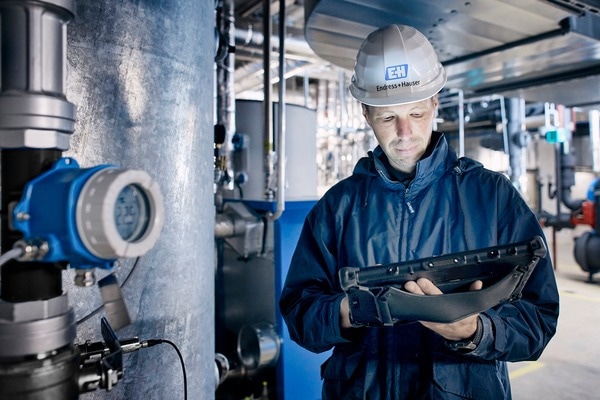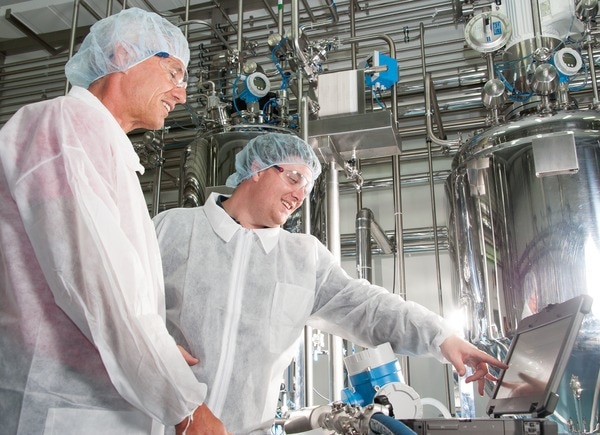In this interview, industry experts Bethany Silva and Jason Pennington explore how predictive maintenance and digital tools are transforming equipment reliability, calibration, and operational efficiency across life sciences and manufacturing.
Can you start by explaining the difference between preventative and predictive maintenance, and why so many industries are now shifting toward the predictive model?
Bethany Silva: Preventative maintenance is typically based on a fixed schedule or routine, performing maintenance tasks at set time intervals to prevent failures. This often requires planned downtime, such as scheduled shutdowns, to carry out inspections or replacements, even if the equipment is still operating within tolerance. I like to compare it to changing a car tire in case it goes flat; you’re acting to prevent failure, but without knowing if an issue truly exists.
Predictive maintenance, on the other hand, takes a proactive and data-driven approach. By continuously monitoring instruments and collecting diagnostic data, we can identify early signs of wear or performance drift before failure occurs. It’s like having a dashboard for your sensors, providing insight into the health of your process equipment in real time so you can intervene at the optimal moment. This approach increases reliability, reduces unplanned downtime, and ultimately saves costs on both maintenance and calibration.

Image Credit: Endress+Hauser
What are some key benefits of predictive maintenance compared to traditional strategies?
Bethany Silva: There are several compelling benefits. Predictive maintenance greatly increases equipment reliability and productivity because it allows us to act before issues become failures. It also reduces maintenance and calibration costs by avoiding unnecessary manual interventions, which are both time-consuming and expensive.
Another major advantage is the reduced risk between calibration intervals. Traditional calibration schedules can leave long “blind spots” where you have no visibility into instrument performance. Predictive tools fill in those gaps by continuously verifying instrument health. This approach also brings more flexibility to production schedules, since you can plan interventions around actual needs rather than arbitrary time frames.
Finally, predictive maintenance helps optimize calibration cycles using real data rather than fixed SOPs and reduces human error by minimizing the need for manual handling. The overall result is a smarter, more cost-efficient maintenance strategy.
You mentioned calibration intervals and verification. How does Endress+Hauser’s Heartbeat Technology support predictive maintenance and continuous verification?
Bethany Silva: Heartbeat Technology is our built-in verification system for Endress+Hauser instruments. It provides continuous self-diagnostics and onboard monitoring in real time without requiring manual intervention or process interruption. This means verifications can be done inline while the process runs rather than during downtime.
Heartbeat offers automated verification documentation and is third-party tested by TÜV, confirming 95% total test coverage. It checks every critical component of the instrument, such as the inlet and outlet pickup coils, measuring tubes, and temperature elements. Essentially, it monitors the device's health continuously and notifies users if anything drifts out of tolerance.
This gives customers complete visibility between calibration intervals, reducing risk and ensuring consistent measurement reliability. The data can be accessed remotely or automatically logged, and verification can be scheduled at defined intervals, or even after each batch, without needing technicians on the floor.
How do these verification systems evolve toward fully predictive or even prescriptive maintenance?
Bethany Silva: The next step after predictive is prescriptive maintenance, which uses AI algorithms and historical data to forecast when an asset will likely fail. Heartbeat Technology lays that foundation by generating detailed diagnostic data over time.
For example, with technologies like our free space radar, we create a unique “fingerprint” of each sensor when it leaves the factory. Heartbeat continuously compares live performance against that fingerprint, tracking deviation or drift. By analyzing those historical patterns, we can start predicting future performance and proactively schedule maintenance only when needed.
Ultimately, this data-driven approach allows plants to fine-tune maintenance frequencies, reduce unplanned downtime, and move toward fully autonomous, prescriptive strategies.
Beyond verification, is it possible to perform true inline calibrations as part of predictive maintenance?
Bethany Silva: Yes, in some cases, it is. We now have a temperature sensor that can perform a true, inline, one-point calibration. While this doesn’t replace the need for full three-point calibrations for certain RTDs, it provides another layer of assurance by allowing real-time calibration without removing the sensor from the process.
Traditional calibrations require skilled personnel, sensor removal, and manual comparison against reference standards, all of which introduce uncertainty and risk. Our self-calibrating RTD contains a built-in NIST traceable ceramic reference that enables automated calibration within the sensor itself. When the process temperature reaches around 118 °C, a natural phase change in the ceramic reference triggers an internal comparison. The system automatically checks itself and sends any discrepancies or offset alerts to the control system.
This means you get continuous accuracy validation without interrupting operations or needing manual intervention. It’s a significant step toward fully automated calibration workflows.
Jason, could you explain how Endress+Hauser supports customers with digital tools and infrastructure for predictive maintenance?
Jason Pennington: My focus is on connecting people, processes, and things through digitalization. We don’t adopt technology for technology’s sake; we apply it to generate actionable outcomes.
We often start with a service called Install Base Analysis (IBA). Our technicians work alongside customer teams to audit every instrument in the facility, cataloguing each device by type, criticality, and maintenance history. Using our Netilion platform, we organize all documentation, calibration reports, and serial numbers, keeping them up to date and traceable.
Netilion has modules such as Library, for storing documentation and service histories, and Analytics, which highlights device attributes like firmware versions, lifecycle status, and replacement recommendations. From there, customers can generate calibration schedules, organize SOPs, and track real-time maintenance events.
The result is a complete digital twin of their installed base, enabling data-driven decision making and a more proactive maintenance approach.

Image Credit: Endress+Hauser
Can you share an example of how this digital approach looks in practice?
Jason Pennington: Sure. One example is a chemical facility we worked with that had nearly 800 devices. Within three days, all assets were catalogued and uploaded to the Netilion portal, complete with model numbers, firmware revisions, and criticality ratings.
From there, the customer could track every maintenance event, generate calibration reminders, and review diagnostic events through standardized alarm codes (NAMUR NE 107). The system automatically categorized alarms, highlighted the type of maintenance required, and suggested corrective actions based on historical data.
This allowed them to transition from reactive troubleshooting to continuous improvement, planning maintenance proactively instead of responding to failures.
What about integrating real-time data for predictive insights? How does Endress+Hauser enable that?
Jason Pennington: We often help customers connect smart devices through a secondary, secure information network, which I call a “reliability network.” This setup allows diagnostic and health data from HART, Ethernet IP, or other protocols to be broadcast wirelessly through a gateway without interfering with the control system or PLC.
For example, using wireless HART adapters and Netilion gateways, we can transmit live device health data to dashboards and analytics tools. If a device starts drifting or a failure is detected, the system can suggest remedies in under a minute, cutting troubleshooting time from hours to minutes.
This data is securely integrated with maintenance management systems (like CMMS), historians, or SCADA platforms via standard APIs, giving maintenance teams immediate visibility into equipment health and enabling data-driven maintenance planning.
How are customers in life sciences and manufacturing industries using these digital solutions today?
Jason Pennington: We’re seeing some really innovative applications. For example, one of our life science partners in New York uses our connected infrastructure to focus their technicians only on the most critical assets. Less critical systems, like utilities or effluent monitoring, are managed remotely via Endress+Hauser Help Desk integration.
When an alarm or verification event occurs, the system automatically generates a help ticket in Salesforce, enriched with error codes and suggested remedies. Our technicians can remotely access the site through a secure VPN, diagnose the issue, and provide support without being physically present.
All data is logged through our Netilion Cloud and shared securely with the customer’s cloud (for instance, Microsoft Azure). Their local municipalities even have dashboard access to review effluent quality and compliance reports automatically generated from the system.
This approach saves enormous time, ensures regulatory compliance, and frees skilled staff to focus on high-value production processes rather than routine checks.
 Image Credit: Endress+Hauser
Image Credit: Endress+Hauser
Do you have any real-world examples demonstrating these predictive systems' cost benefits?
Jason Pennington: One example comes from a bottled water producer operating multiple plants. They face tight margins and strict FDA regulations. We performed an Install Base Analysis across five facilities, covering about 25 different manufacturers of instrumentation.
Endress+Hauser now maintains and calibrates the installed base using Netilion Health and the customer’s Rockwell FactoryTalk Historian. Around 60 % of their devices are now maintained automatically through cloud-based verification. The rest, critical FDA-regulated equipment like pasteurizers and filling machines, receive focused technician attention.
The ROI has been very clear: by automating routine verifications and targeting human effort where it matters most, they’ve significantly reduced downtime, extended asset life, and improved compliance documentation.
Finally, what advice would you give organizations just beginning their predictive maintenance journey?
Bethany Silva: Start small and focus on data visibility. Even implementing verification tools like Heartbeat Technology on a few key assets can demonstrate quick wins in reliability and confidence. From there, the digital infrastructure needed for real-time monitoring will be built.
Jason Pennington: I’d add that you shouldn’t pursue digitalization just for the sake of it. First, define your use cases, identify the pain points in your maintenance process, and build your data strategy around solving those. With the right foundation and tools, predictive maintenance quickly shifts from concept to measurable operational value.
About Bethany Silva 
Bethany is responsible for the strategic direction, vision, and growth of the Life Science Industry in the U.S. Bethany has worked with several life science companies with positions in R&D, process development, marketing and technical sales. She brings 20 years of experience in sales and marketing to the role, 11 years dedicated to life sciences.
About Jason Pennington 
Jason Pennington holds an MBA and a degree in Electrical Engineering Technology. At Endress+Hauser, he serves as Director of Digital Solutions, leading digital transformation initiatives and managing cloud-based platforms, connectivity strategies, and cybersecurity efforts to enhance industrial automation and process efficiency across the U.S. market.

This information has been sourced, reviewed and adapted from materials provided by Endress+Hauser Ltd.
For more information on this source, please visit Endress+Hauser Ltd.
Disclaimer: The views expressed here are those of the interviewee and do not necessarily represent the views of AZoM.com Limited (T/A) AZoNetwork, the owner and operator of this website. This disclaimer forms part of the Terms and Conditions of use of this website.